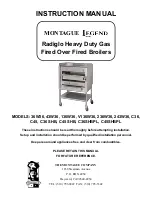
I
NSTALLATION (continued)
PAGE 12
______________________________________________________________________________________________________________________________________________________________________________________
CHIMNEY REQUIREMENTS (continued)
•
Your Tarm EXCEL boiler is designed to burn efficiently and nearly smoke-free, but under
certain conditions creosote deposits may form in your chimney. Chimneys that are too
large, are located outside, are poorly insulated, or have bends in the flue passages are
especially prone to problems with draft and/or creosote.
•
If the chimney is too short and/or there is not enough draft, it may be necessary to add a
draft inducing fan. However, we suggest that you determine first whether there are any
easy solutions to your draft problems before you invest in a draft inducer.
•
DRAFT
REGULATORS: Strong wind blowing across the top of a chimney or a chimney
which has a particularly strong natural draft can cause the Tarm EXCEL boiler to
continue burning (heating) when the draft fan is off. This should not be allowed to
happen because it can cause creosote formation and/or overheating of the boiler. The
solution to this problem of excessively high or irregular draft is to use a barometric draft
regulator in the smoke pipe, which we strongly recommend. A Barometric Draft
Regulator is required for a proper oil burner installation, and a duel-acting Barometric
Damper with a manual reset spill switch is required for a gas burner installation.
•
TURBULATORS: may be added to the wood burning heat exchange tubes increasing
heat exchange efficiency and restricting draft. However, there is some risk that
turbulators will cause the exhaust gases to cool too much which will lead to undesirable
condensation in the chimney connector and/or flue. Turbulators are usually not
recommended for wood burning unless the boiler is installed with a heat storage system.
•
The smoke pipe connecting the Tarm EXCEL boiler to the chimney flue should be black
or stainless steel, have a minimum thickness of 24 gauge, and must rise a minimum of
1/4” per foot run toward the chimney. Smoke pipe sections must be attached to one
another with a minimum of three sheet metal screws.
•
MASONRY
CHIMNEYS: Masonry chimneys must be lined, either with code-approved
masonry or pre-cast refractory tiles, stainless steel pipe, or a “poured-in-place” liner. Do
not use an unlined chimney.
•
An existing chimney should be examined for cracks, loose mortar, other signs of
deterioration, and blockage. Repair any defects or reline the chimney before use.
•
The chimney’s clean-out door must seal tightly.
•
A newly-built masonry chimney must conform to local or national codes.
•
FACTORY-BUILT CHIMNEYS: Factory-Built chimneys must be tested and listed for
use with solid-fuel burning appliances to the High-Temperature (H.T.) Standard
(2100
°
F), UL 103, for the United States and High Temperature (650
°
C) Standard ULCS-
629 for Canada. Factory-Built chimneys must be installed as per the manufacturers
instructions.
12
Summary of Contents for 2000
Page 1: ......
Page 4: ......
Page 8: ... Intentionally left blank PAGE 4 4 ...
Page 13: ...FEATURES AND SPECIFICATIONS PAGE 9 9 ...
Page 28: ...FIELD WIRING DIAGRAMS PAGE 24 ...
Page 29: ...24 WIRING SCHEMATIC FOR CONTROLS PAGE 25 ...
Page 30: ...This is an insert page 25 ...
Page 63: ...TARM EXCEL CAUTION LABEL PAGE 58 58 ...
Page 65: ...BOILER Parts List PAGE 60 60 ...
Page 66: ...BOILER Parts List PAGE 61 61 ...
















































